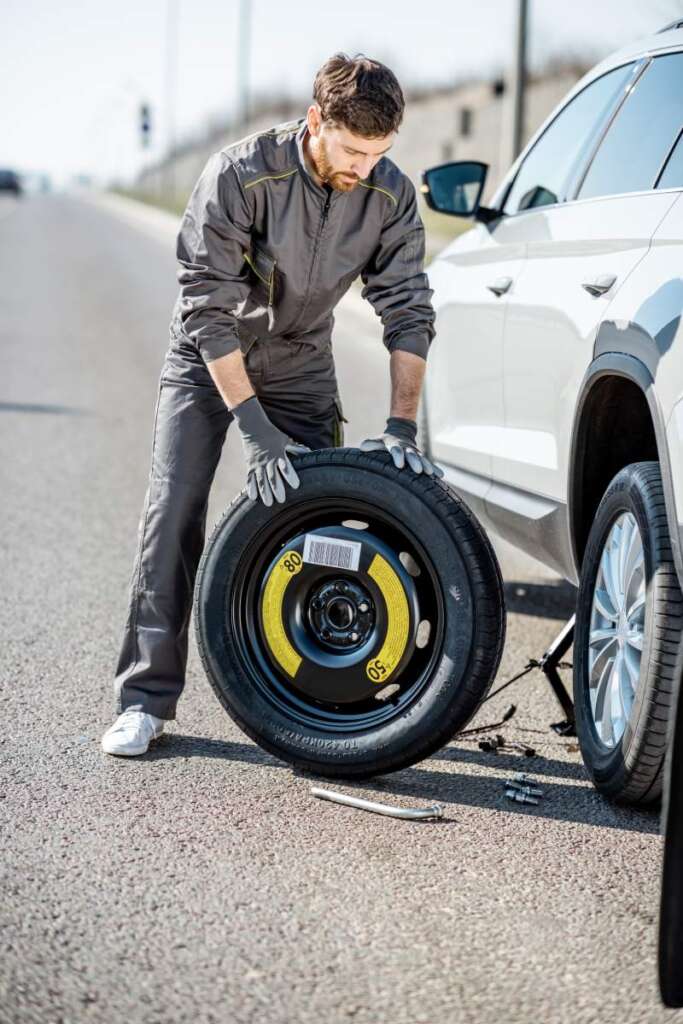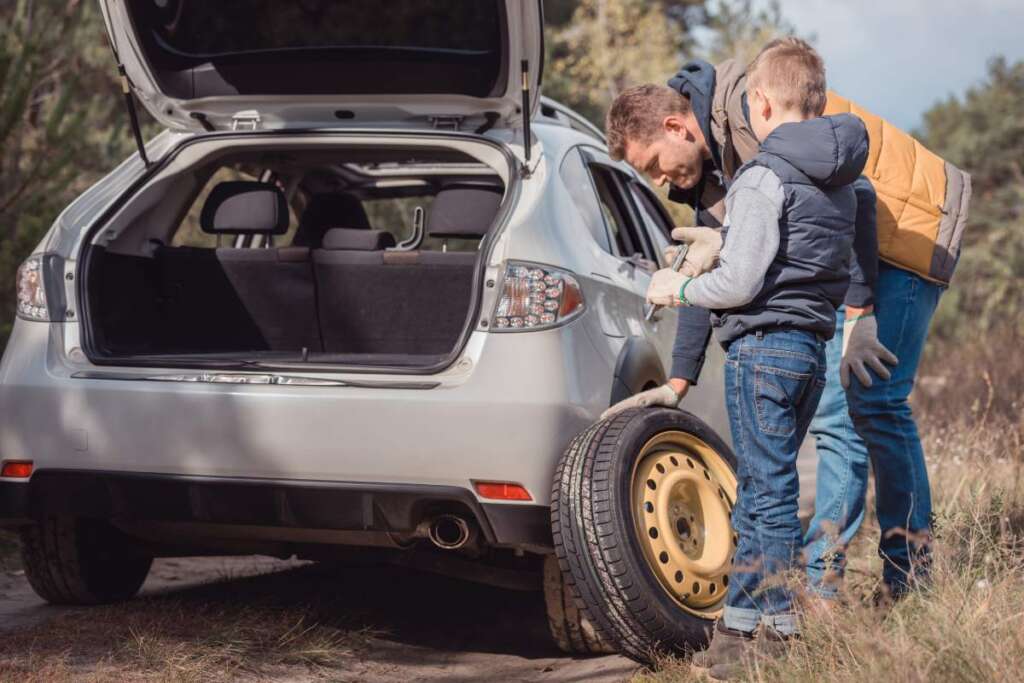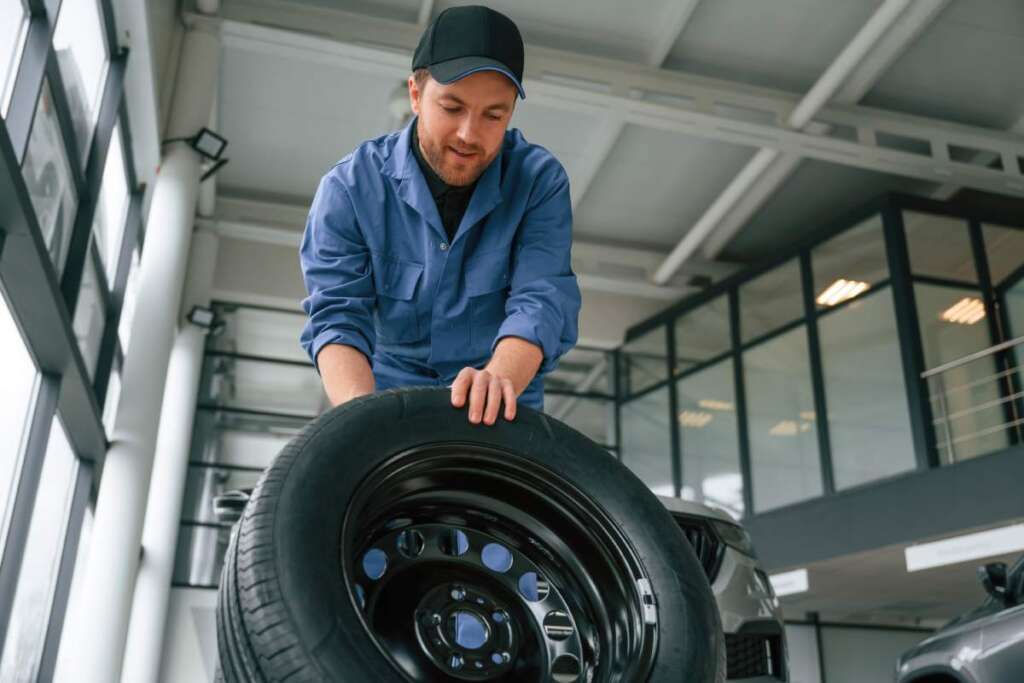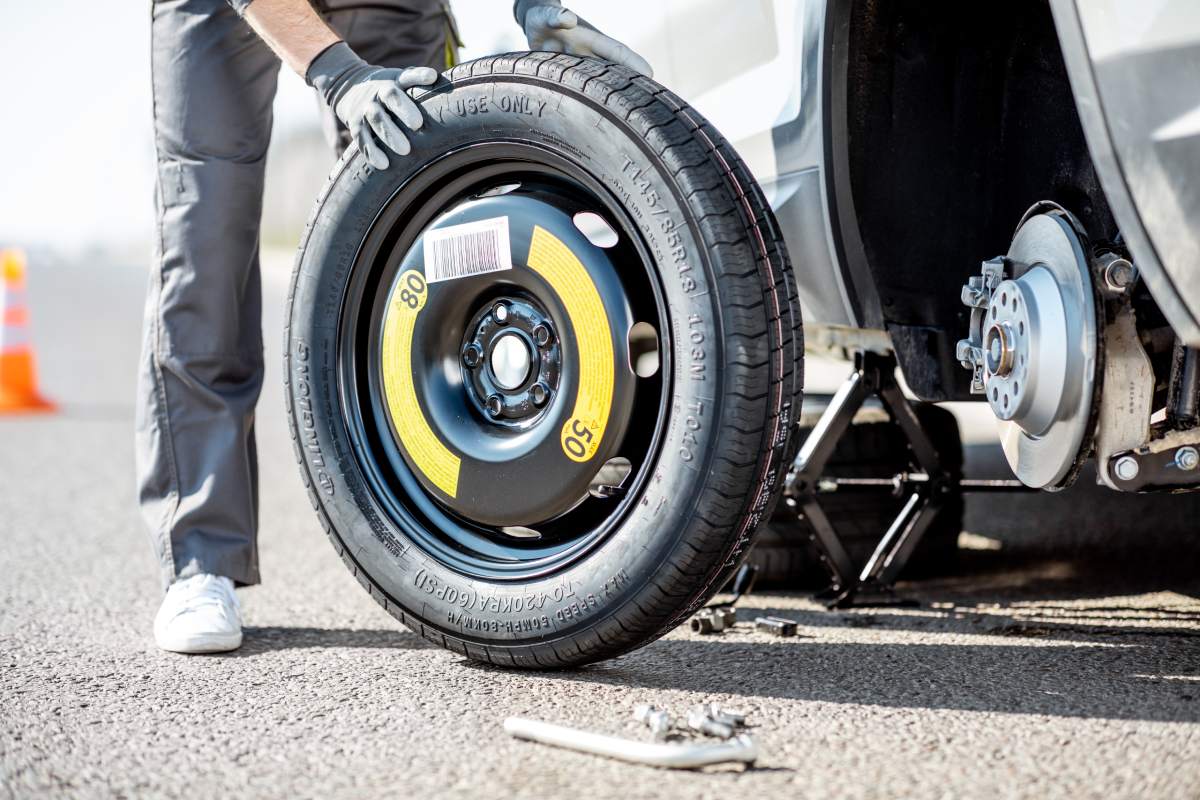A flat tyre is one of those inconvenient things that can happen when you’re least prepared for it. Whether you’re on a busy road or in a remote location, knowing how to change a spare tyre can save you time and frustration.
In this article, we’ll provide you with step-by-step instructions on changing a spare tyre safely, as well as discuss how long a spare tyre can last and tips to maximize its lifespan.
Step-by-Step Guide: How to Change a Spare Tyre

- Pull Over to a Safe Location When you realize you have a flat tyre, the first thing to do is find a safe spot to pull over. If you’re on a busy road or highway, try to get as far off the road as possible and find a flat, level surface. Avoid changing your tyre on a hill, as this could cause the car to roll. Turn on your hazard lights to alert other drivers.
- Apply the Handbrake and Turn Off the Engine Once you’ve found a safe spot, turn off your engine and engage the handbrake to ensure your car doesn’t move while you’re working on it.
- Gather Your Tools You’ll need the following tools to change the tyre:
- Spare tyre
- Car jack
- Lug wrench (also called a tyre iron)
- Wheel chocks (optional but recommended)
- Gloves (to keep your hands clean and protect them)
- Loosen the Lug Nuts Using your lug wrench, slightly loosen the lug nuts (the bolts that secure the wheel) before you jack up the car. Turn the wrench counterclockwise to loosen them. You might need to apply some force to get them to budge, especially if they were tightened with a pneumatic tool. It’s important to loosen the lug nuts while the car is still on the ground to avoid the wheel spinning.
- Position the Jack Look for your car’s jacking point, which is typically located under the frame near the flat tyre. Place the jack under this point and slowly begin to raise the car. Be sure the jack is positioned on solid ground. Raise the car until the flat tyre is lifted off the ground, allowing enough clearance to install the spare tyre.
- Remove the Flat Tyre Once the car is lifted, completely remove the loosened lug nuts. Set them aside in a secure spot so they don’t roll away. Now, pull the flat tyre off the wheelbase and set it aside.
- Install the Spare Tyre Align the spare tyre with the lug nut posts and push it onto the wheelbase. Once the spare tyre is securely in place, hand-tighten the lug nuts back onto the posts as much as you can.
- Lower the Car Use the jack to slowly lower the car back down to the ground. Once the car is firmly on the ground, use the lug wrench to fully tighten the lug nuts in a star pattern. This ensures that the wheel is secured evenly. Avoid overtightening, but make sure they are snug.
- Check the Tyre Pressure After the spare tyre is in place, check its air pressure using a tyre pressure gauge. The recommended tyre pressure can be found in your vehicle’s manual or on the tyre placard located on the driver’s side door. Most spare tyres have different pressure requirements than regular tyres.
- Pack Away Tools and Flat Tyre Once everything is secured, pack away the jack, wrench, and the flat tyre. Make sure nothing is left behind.
- Drive to a Mechanic A spare tyre is a temporary solution, not a permanent one. Head to a tyre shop or mechanic as soon as possible to get your regular tyre repaired or replaced.

How Long Can a Spare Tyre Last?
Spare tyres are not designed for long-term use, so it’s crucial to understand their limitations. The lifespan of a spare tyre depends on two main factors: type of spare tyre and the distance driven.
1. Types of Spare Tyres
- Full-Size Spare Tyre: These tyres are the same size as your regular tyres and can be used just like them. If your spare tyre is full-sized, you can drive on it for a longer period, but it’s still recommended to switch back to your regular tyre as soon as possible.
- Compact (Donut) Spare Tyre: Most cars come with a compact spare tyre, often referred to as a “donut.” These tyres are smaller and thinner than regular tyres and are designed to be lightweight and space-saving. However, they have limited tread and lower durability. They’re intended only for short-term use.
2. Distance and Speed
- Distance: Donut tyres are typically rated to last up to 80 kilometres, though some might allow you to drive up to 100 kilometres. After this, their limited tread and structure make them prone to wearing out faster.
- Speed: Most compact spare tyres come with a speed limit recommendation of around 80 km/h. Exceeding this limit could result in the spare tyre wearing out prematurely or even failing, which can be dangerous.
3. Age of the Spare Tyre
Even if you haven’t used the spare tyre, it doesn’t mean it’s in perfect condition. Rubber deteriorates over time, especially when exposed to temperature changes and moisture in the boot. If your spare tyre is more than six years old, you should consider replacing it even if it looks unused.
4. Conditions of Use
Driving on rough terrain or in extreme weather conditions can wear out a spare tyre much faster. If you’re driving in these conditions, try to limit the use of a spare tyre to the bare minimum.
Maintenance Tips for Spare Tyres
To ensure your spare tyre is ready for use when needed, here are some maintenance tips:
- Regularly Check Air Pressure: Spare tyres can lose air over time, so it’s important to check their pressure periodically. Keeping it at the manufacturer’s recommended pressure will ensure it’s ready when you need it.
- Inspect for Wear: Even though you may not use your spare tyre often, it’s a good idea to check it for cracks, bulges, or other signs of wear. An old or damaged spare tyre won’t perform well when needed.
- Store it Properly: Make sure the spare tyre is properly secured in your boot and free from moisture. Improper storage can lead to rubber degradation.

Should Keep the Spare Tyre After Using It or Replace It?
Whether you should keep the spare tyre after using it or replace it depends on the type of spare tyre and its condition after use.
1. Full-Size Spare Tyre
- Can You Keep It? Yes, a full-size spare tyre can be used just like a regular tyre. If it’s still in good condition after use (no significant wear, no damage), you can keep it and continue using it as a backup.
- When to Replace It? If the full-size spare tyre has been used for an extended period or shows signs of wear, such as worn tread, punctures, or cracks, you should consider replacing it. Also, if the spare is older than 6 years, it may be wise to get a new one, as the rubber degrades over time.
2. Compact (Donut) Spare Tyre
- Can You Keep It? These tyres are designed for temporary use only, usually for distances up to 80-100 kilometres and speeds not exceeding 80 km/h. After using a compact spare tyre, it’s recommended that you get your original tyre repaired or replaced as soon as possible.
- When to Replace It? If you’ve driven on the compact spare tyre for a significant distance or at high speeds, it’s a good idea to replace it with a new one. These tyres wear out quickly due to their smaller size and limited durability. Even if you haven’t used it much, replace it if it’s older than 6 years or if it shows signs of wear or damage.
General Guidelines:
- Check for Damage: Always inspect the spare tyre after using it. Look for any punctures, cracks, or worn tread that might make it unsafe for future use.
- Age of the Tyre: Tyres degrade with age, even if they aren’t used. If your spare is old (over 6 years), it’s better to replace it, regardless of its condition.
In summary, you can keep a full-size spare tyre after using it if it’s in good condition, but for a compact spare tyre, it’s best to replace it after use, especially if it’s been driven for a while or shows signs of wear. Always inspect the condition of the spare tyre before deciding to reuse it.
Conclusion
Knowing how to change a spare tyre and understanding its limitations can keep you safe on the road and help you avoid potential breakdowns. While spare tyres are convenient in emergencies, they are not meant for long-term use.
Whether you have a full-size or compact spare, the key is to get your flat tyre repaired or replaced as soon as possible. By maintaining your spare tyre and keeping your tools handy, you’ll be prepared for any unexpected tyre issues on the road.

